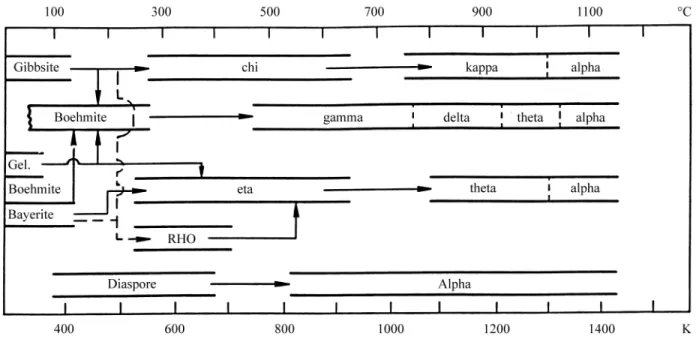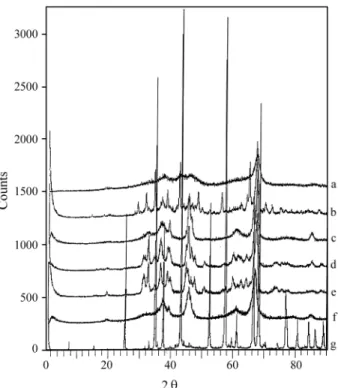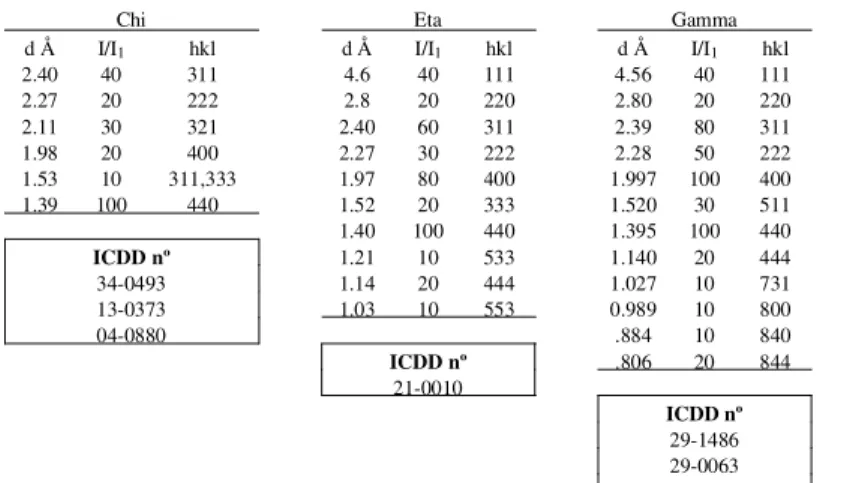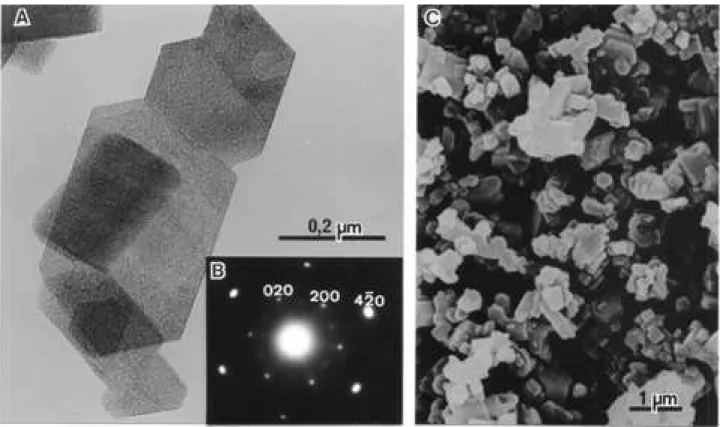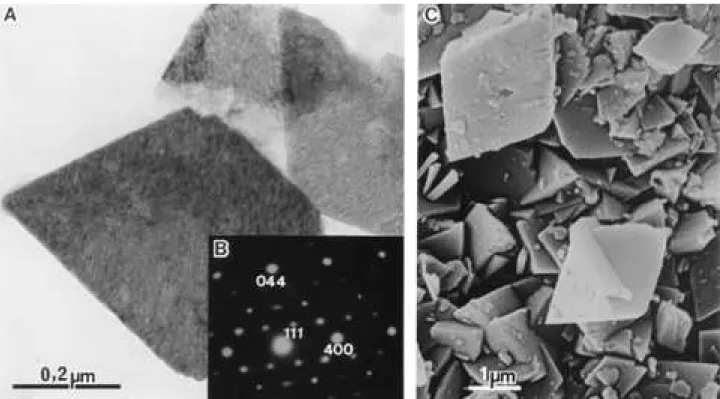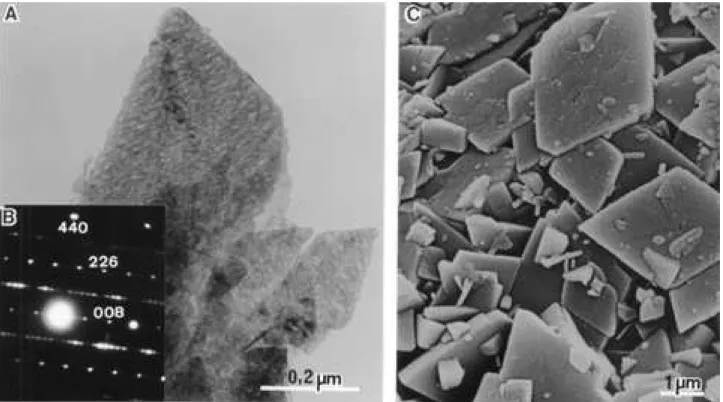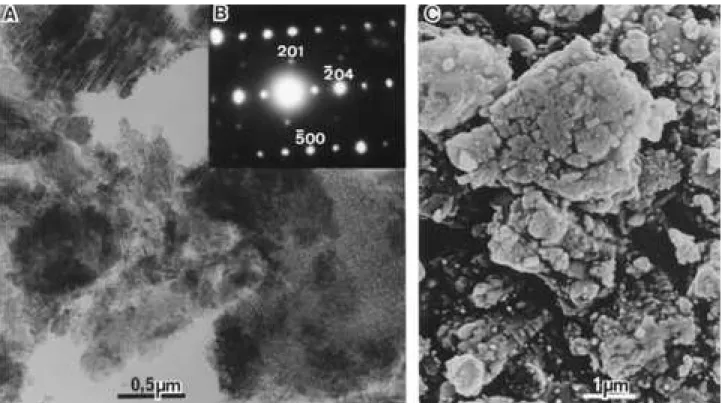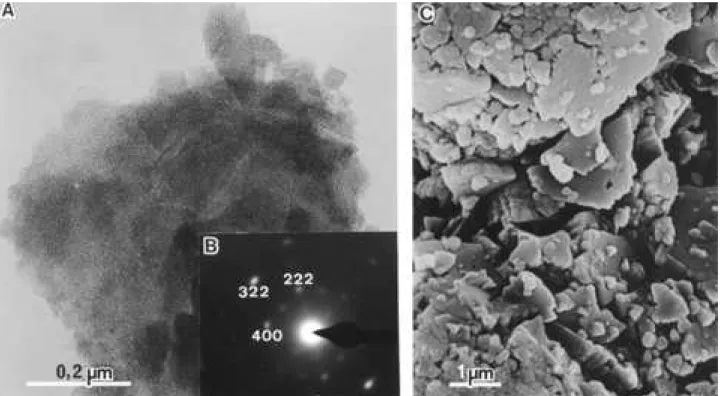Standard Transition Aluminas. Electron Microscopy Studies
P. Souza Santosa, H. Souza Santos*b, S.P. Toledob
a
Laboratório de Matérias-Primas Particuladas e Sólidos Não Metálicos, Departamento de Engenharia Química, Escola Politécnica,
Universidade de São Paulo, São Paulo, SP, Brazil b
Laboratório de Microscopia Eletrônica, Departamento de Física Geral, Instituto de Física, Universidade de São Paulo, São Paulo, SP, Brazil
Received: May 30, 2000; Revised: November 17, 2000
The aim of this paper is to present the results of characterization of the particle shapes of six standard transition aluminas samples using transmission and scanning electron microscopies; selected area electron diffraction, in parallel with X-ray powder diffraction were used for confirma-tion of the different transiconfirma-tion aluminas types. The transiconfirma-tion aluminas - chi; kappa; gamma; theta; delta; and eta were supplied by ALCOA Central Laboratory. The chi-; kappa-;gamma- and delta-Al203microcrystals are pseudomorphs from their respective precursors gibbsite and boehmite.
However, theta-Al203microcrystals are not pseudomorphs after the standard delta-Al203sample.
Also, eta-Al203are not pseudomorphs after bayerite somatoids.
Keywords:transition aluminas, alumina precursors, gibbsite, electron microscopies
1. Introduction
1.1. Corundum
A crystalline element or a solid inorganic chemical compound formed by a geological process is a mineral and therefore receives a specific name. Natural crystalline alu-minum oxide or alumina (Al203) is named corundum; the
monocrystals* are colorless and transparent. If they con-tain, intimately mixed, microcrystals of magnetite (Fe304)
or hematite (Fe203), they are called emery. If the corundum
monocrystals contain some elements in isomorphic substi-tutiton for Al3+in their structure, gemstones and semi-pre-cious gemstones are formed, also receiving specific names for their colors: (a) sapphire - blue (Fe, Ti); (b) ruby - red (Cr); oriental topaz - yellow (Fe3+, Fe2+); amethyst - purple (Fe, Mn, Ti); oriental emerald - green (Fe2+).
Since, by definition, a mineral is formed in Nature, the expression “synthetic mineral” may be criticized. How-ever, it is used for synthetic rubies and sapphires that are industrially produced today by the Verneuil (oxi - hydrogen flame) or by hydrothermal processes2.
It is a common practice in X-Ray Crystallography to take the crystalline structures of some minerals (and also of some chemical compounds) as standards, these structures receiving the name of the mineral. The crystal structure of
corundum is called corundum structure, but also is called
α-Al203or alpha-alumina structure (Krebs3).
1.2. Alpha-alumina
It was an old recommendation in gravimetric chemical analysis to heat the white gelatinous precipitate of alumi-num hydroxide at temperatures above 1200 °C to “stabi-lize” it for weighing the alumina formed at lower temperatures; the aluminas, if not heated above 1200 °C, adsorbed water vapor very fast and no equilibrium was reached for the weighing. The alumina heated above 1200 °C was named alpha-alumina in 1916 by Rankin and Merwin4; the use of Greek letters was an old common practice in Chemistry to distinguish between compounds with exactly the same composition, but having different physico-chemical properties. These authors also proposed a new beta-alumina, which will be discussed later. The nameβ-Al203was also given by Rankin + Merwin4to a Na
- containing alumina. Theα-alumina prepared by heating aluminum hydroxides is a finely divided powder consti-tuted by micrometer sized particles. After the Debye-Scher-rer X-ray powder method was developed in 1916, soon it was shown that theα-alumina particles are micro-crystals with the same crystalline structure of the mineral corun-dum. Today, the expression more frequently used isα -alu-mina crystalline structure. Presently, α-Al203 has many
uses in Traditional and Advanced Ceramics; particularly, is an important substrate for the growth of the superconduc-tors and semiconducsuperconduc-tors by molecular beam epitaxy.
1.3. Transition Aluminas
The aluminas, heated at temperatures under 1100 °C, were considered in the early days of X-ray powder diffrac-tion method as amorphous or non-crystalline materials, in spite of the fact that they have important adsorptive and catalytic properties; in other words, they were considered very ill defined and complex materials, that above 1100 °C changed into crystallineα-alumina; sometimes, they were loosely called “gamma-alumina” by Ulrich5.
Later, it was recognized6the existence of five
crystal-line aluminum hydroxides: gibbsite; bayerite; nord-strandite; diaspore; and boehmite; they have crystals varying from micro to milimetric size; their dehydroxila-tion occurs by heating between 300 °C and 600 °C and aluminas are formed, all as micrometer sized powders; these fine grained powders change their structure at 1100 °C, but remain as powders; increasing the tempera-tures from 1100 °C up to near the melting point ofα-Al203
(2050 °C), the powder particles start to coalesce, sinter and recrystallize as microplatelets of hexagonal profile or even hexagonal prisms withα-Al203structure; they are called
“tabular crystals” of aluminas and must not be confused with the commercial product patented under the name “tabular alumina”. The formation of the hexagonal crystals ofα-Al2 03 may be accelerated by the addition of 0.1%
AlF3.
Stumpfet al.6(from ALCOA’S Research Laboratories, now Technical Center, Pittsburgh, USA), showed that,
between the temperatures of dehydroxilation of the alumi-num hydroxides and the alpha-alumina first crystallization, a number of well characterized and reproducible interme-diate crystalline alumina structures are formed; each one has a stable different crystalline structure at a given tem-perature range, with just one exception which is “amor-phous”.
The type or structure of each alumina and its tempera-ture range of existence are determined by the structempera-ture of the starting or precursor hydroxide; they are different for gibbsite, bayerite, nordstrandite, boehmite or diaspore* . Extensive literature exists on the dehydroxilation of the crystalline hydroxides, in special on gibbsite, because it is the phase formed in the industrial Bayer Process. These seven aluminas are called “Transition Aluminas” and re-ceived Greek letters to identify them: gamma; delta; theta; kappa; chi; eta and rho. Figure 1 is adapted from the most recent review7of the thermal transformation sequence:
aluminum hydroxide→transition aluminas→ α- Al203
From Fig. 1, may be concluded that all Transition Aluminas may be produced from gibbsite; that fact is one reason more for the industrial importance of the Bayer gibbsite. All Transition Aluminas are synthetic.
The five crystalline hydroxides can be synthetic or natural; from either origin, the Transition Aluminas are formed under firing. These same Transition Aluminas may also be formed by pyrolysis of crystalline hydrates of aluminum salts as sulphate; nitrate; ammonium alum; chlo-ride; formate; and hydroxiacetate. Other methods for pre-paring Transition Aluminas are reviewed by Wefers and Misra7.
* In order to be coherent, the crystalline Al-hydroxides should have standard names for their structures; in fact they have, but nordstrandite has none7;
so, it became common practice to use the mineral name to designate the hydroxides, natural or synthetic.
Figure 1.Thermal transformation sequence of the aluminum hydroxides (adapted from Ref. 7).
In spite of its Greek letter,α-Al203is not a transition
alumina, but is the last crystalline material formed by the effect of increasing temperatures on the transition alumi-nas. Also, beta-Al203is not a transition alumina; it has the
composition Na20.11Al203and has use as a ceramic
elec-trolyte; today, a whole family of beta-aluminas exists, containing groups I and II cations and with several molar ratios, generaly between 5 and 9.
It is interesting to point out that alumina plasma sprayed onto a cooled substrate is known to solidify in the form of one or more metastable or transition aluminas; the most frequent is gamma-Al203, which by annealing reverts toα
-through delta-Al203.
The Transition Aluminas cannot be considered true polymorphs ofα-Al203. The low temperature ones in
par-ticular may contain some residual 0H anions. Moreover, as pointed above, the sequence of transformation is not revers-ible, that is, neitherα-Al203nor any of the high temperature
aluminas can be converted to one of the Transition Alumi-nas that occur at a lower temperature. Therefore, according to Wefers and Misra7they may be classified as thermodi-namically unstable, although reproducible, states of struc-tural reordering of the α-Al203 structure. Some authors9
prefer to call them “metastable alumina polymorphs”. So, Fig. 1 is a schematic diagram that only indicates general temperature ranges in which the Transition Alumi-nas occur, but should not be considered a “phase diagram”. It is common that more than one form may be present simultaneously within a crystal of a decomposed hydroxide or oxide.
Stumptet al6have observed that the same Transition Aluminas are encountered after short and long heating periods: the observed effect of long holding at the same temperature is merely to lower the transformation tempera-tures of the Transition Aluminas8.
The Transition Aluminas have uses in ceramics, par-ticularly as adsorbents, catalysts, coatings and soft abra-sives.
According to Gitzen10, also from ALCOA, other inves-tigators have, since 1950, discovered new transition alu-mina phases or disagreed with the published X-ray patterns or even with the existence of the seven listed phases. The aluminum oxide films formed on aluminum by electrolytic oxidation (anodization) and fired at 800 °C have gamma-Al203structure. Direct thermal oxidation of aluminum
met-al foils produces a new “epsilon-met-alumina”; as it does not comes from an Al-hydroxide precursor, it is not considered a transition alumina.
Table 1 shows the X-Ray Powder Data of the Transition Aluminas and of α-Al203 and Fig. 2 shows their X-Ray
Powder Diffraction Curves.
As pointed before, all the seven Transition Aluminas are naturally micrometer sized particles, because their
pre-cursors were fine grained synthetic aluminum hydroxides particles; Rooksby11; Bye and Simpkin12improved the
crystallinity of gamma-, delta-, theta- and kappa-aluminas by the effect of addition of Mo, V, Cr and Fe, with various temperature and time treatments.
Very small amount of published information exists on the particle shapes obtained by transmission electron mi-croscopy of the transition aluminas, the majority being supplied by ALCOA’S investigators. Transition aluminas crystals with the structures of gamma-, delta- and theta-Al203crystals were studied using high resolution electron
microscopy (HREM) by Iijima13, by Morrisseyet al.14and
more recently, by Levin and Brandon9; Morrisseyet al.14 wrote: “Although the existence of the transition aluminas, specifically gamma-, delta- and theta-aluminas have been recognized for many years, their structure is still not well understood. Lack of structural information is due in part to the growth characteristics of these forms of alumina. Large single crystals of these materials cannot be made...”. The phase transformation during calcination of the aluminum hydroxides was firstly studied employing SAED by Lip-pens and De Boer15. The growth ofα-Al203by CVD was
studied by Sears and De Vries16. The morphologies of particles and agglomerates of several commercial aluminas and aluminum hydroxides were described using scanning electron microscopy by Castroet al.17and by Passaro and Souza Santos18.
Figure 2.X-ray diffraction powder curves of: (a) chi-Al203; (b)
kappa-Al203; (c) gamma-Al203; (d) delta-Al203; (e) theta-Al203; (f) eta-Al203; (g)
Table 1.X-ray diffraction data of transition aluminas and oxide
Chi Eta Gamma Kappa Theta Delta Corundumα-Al2O3
d Å I/I1 hkl d Å I/I1 hkl d Å I/I1 hkl d Å I/I1 d Å I/I1 hkl d Å I/I1 hkl d Å I/I1 hkl
2.40 40 311 4.6 40 111 4.56 40 111 6.2 30 5.70 2 200 7.6 4 101 3.479 75 012
2.27 20 222 2.8 20 220 2.80 20 220 4.5 20 5.45 10 001 6.4 4 102,004 2.552 90 104
2.11 30 321 2.40 60 311 2.39 80 311 4.2 10 4.54 18 201 5.53 4 111 2.379 40 110
1.98 20 400 2.27 30 222 2.28 50 222 3.04 40 2.837 80 400,401 5.10 8 112 2.165 <1 006
1.53 10 311,333 1.97 80 400 1.997 100 400 2.79 60 2.730 65 202,002 4.57 12 113 2.085 100 113
1.39 100 440 1.52 20 333 1.520 30 511 2.70 20 2.566 14 111 4.07 12 114,105
1.40 100 440 1.395 100 440 2.57 80 2.444 60 111 3.61 4 115 1.964 1 202
ICDD nº 1.21 10 533 1.140 20 444 2.41 30 2.315 45 401,310 3.23 4 116 1.740 45 024
34-0493 1.14 20 444 1.027 10 731 2.32 40 2.257 35 402,202 3.05 4 107,214 1.601 80 116
13-0373 1.03 10 553 0.989 10 800 2.26 10 2.019 45 311,112 2.881 8 117 1.546 3 211
04-0880 .884 10 840 2.16 10 1.9544 8 601 2.728 30 222 1.514 5 122
ICDD nº .806 20 844 2.11 80 1.9094 30 600,312 2.601 25 302,118
21-0010 2.06 30 1.7998 14 510 2.460 60 312 1.510 7 018
ICDD nº 1.99 40 1.7765 6 602,402 2.402 16 313 1.404 30 124
29-1486 1.95 20 1.7376 4 403 2.315 8 314,305 1.374 50 030
29-0063 1.87 60 1.6807 2 601 2.279 40 226 1.337 1 125
10-0425 1.82 30 1.6216 6 203,511 2.160 4 1.1.10 1.276 3 208
1.74 20 1.5715 2 113 1.986 75 400
1.64 60 1.5426 25 313 1.953 40 0.0.12 1.293 15 1.0.10
1.54 10 1.5120 6 603 1.914 12 318 1.2343 7 119
1.49 30 1.4883 25 113,801 1.827 4 319,2.2.10 1.1898 7 220
1.45 30 1.4526 25 020 1.810 8 426,3.1.11 1.1600 <1 306
1.43 80 1.4264 10 800,710 1.628 8 1.1.14 1.1470 5 223
1.39 100 1.3883 100 712,512 1.604 4 513
1.34 30 1.538 8 1.1.15 1.1382 1 311
1.12 10 ICDD nº 1.517 16 523,516 1.1255 5 312
1.06 10 35-0121 1.456 8 440 1.1246 3 128
1.04 5 11-0517 1.407 50 4.0.12 1.0988 7 0.2.10
1.02 5 23-1009 1.396 100 1.0831 3 0.0.12
1.01 40
0.994 20 ICDD nº 1.0781 7 134
16-0394 1.0426 13 226
ICDD nº 04-0877 1.0175 1 402
04-0878 0.9976 11 1.2.10
0.9857 1.1.12
0.9819 3 404 0.9431 <1 321 0.9413 <1 1.2.11 0.9345 3 318 0.9178 3 229
0.9076 13 324 0.9052 3 0.1.14 0.8991 7 410 0.8884 <1 235
ICDD nº 43-1484 42-1468 10-0173
V
o
l.
3
,
N
o
.
4
,
2
0
0
0
T
ra
n
sitio
n
A
lu
m
in
as
.
E
le
ctr
o
n
M
ic
ro
sc
o
p
y
1
0
1.4. Aim
The purpose of this paper is to describe the particle morphologies as observed by transmission and scanning electron microscopy of six standard transition aluminas samples supplied by ALCOA.
2. Experimental
2.1. Samples
The six Transition Alumina samples (white powders) were kindly supplied by Dr. Karl Wefers, Head of the Surface Technology Group of the ALCOA Technical Cen-ter, Pittsburgh; they belong to the Center collection of chemical standards6. They were previously used for refer-ence in X-ray studies to characterize the aluminas formed in the thermal transformation of synthetic crystals of alu-mi nu m h ex ach lo r id e, h yd r o xi acetate, fib ri llar pseudoboehmite and euhedral boehmite19.
No rho-alumina was supplied, because it is so unstable, that it must be kept permanently under high vacuum. Rho-alumina is formed by the rapid heating in vacuum of gibbsite to 575-700 K (302-427 °C); it is non-crystalline (amorphous to X-rays), very reactive due to its high free energy resulting from lattice disorder and large surface area; in contact with water vapour, gibbsite or boehmite are formed. Rho-Al203is used as an intermediate for the
pro-duction of a type of activated aluminas (with gamma-Al203
structure) and surface areas between 250 and 375m2/g; also Claus catalysts for sulfur production and some hydrogena-tion catalyst supports use an activated alumina which is a mixture of chi-, rho- and eta-aluminas, with surface areas between 275 and 375m2/g20.
As reference, sintered particles of α-Al203 formed at
1200 °C from pseudoboehmite19 and at 1500 °C from microcrystals of synthetic gibbsite, are also presented.
2.2. X-ray diffraction (XRD)
The XRD curves were obtained in a Philips Diffrac-tometer model X-Pert, operating with copper K-alpha ra-diation, at 40 kV and 40 mA; the scanning was conducted between 1° (2θ) and 90° (2θ). Figure 2(a) - (g) shows the XRD powder patterns of the six standard Transition Alu-minas and of theα-Al203samples.
2.3. Electron Optical Examination
Each powder was ultrasonified for 20 min and dry prepared for transmission electron microscopy (TEM), and selected area electron diffraction (SAED), on carbon cov-ered grids; for the scanning electron microscopy (SEM) they were directly placed on the stubs (double face taped) and gold covered in an high vacuum sputtering unit. The preparations were examined in a Philips CM200
transmis-sion electron microscope at 200 kV and in a JEOL JSM 840A scanning electron microscope.
3. Results and Discussion
3.1. chi-Al203
From Fig. 1, it can be concluded that gibbsite is the only aluminum hydroxide that produces chi-alumina crystals by thermal dehydroxilation.
Several authors7,10,21 noted that the dehydration of
gibbsite crystals (Bayer agglomerates) is pseudomorphic, that is, the external shape of the crystals is retained and there is an orientation relationship of the crystal axes of the new phase to those of the original crystal; it seems that the pseudomorphosis goes up to corundum crystallization. As the dehydroxilation leads to a loss of 33% of weight (water vapour), there is an increase in density from 2.42 to 3.98g/cm3; as a consequence, a large internal microporosity
is developped in the chi-Al203crystals. The basic crystal
habit of gibbsite, natural or synthetic, is pseudohexagonal tabular (hexagonal plates), of micrometric size; these crys-tals are named “tabular gibbsite”7.
Figure 3A is a TEM of chi-Al203 crystals; they are
hexagonal plates, most probably pseudomorphic after gibbsite crystals; they present a fine granular texture due to the thin platelets microporosity. X-ray powder pattern lines fully agrees with the ICDD card n ° 04-0880 for chi- Al203;
the X-ray diffraction curve is shown in Fig. 2(a); its SAED pattern confirms the chi-Al203 structure of the platelets
(Fig. 3B).
Figure 3C is a scanning electron micrograph of the chi-Al203powder showing that the platelets exist as small
agglomerates of the platy crystals.
3.2 kappa-Al203
From Fig. 1, it can be seen that kappa-Al203 is only
formed from heating chi-Al203and that it transforms above
1000 °C into alpha-alumina or corundum; from what is written on gibbsite, it should be expected that the transfo-med chi-kappa crystals should be pseudomorphic; in other words, chi- and kappa-Al203crystals would have very close
shapes.
Figure 4A is a TEM of a kappa-Al203crystal: it has an
irregular outline, different from those of Fig. 3A of chi-Al203; however, it shows a development in the internal
porosity: many large voids, appearing as holes, have been formed, probably from the coalecence of several micro-pores.
Figure 2(b) shows the XRD pattern of kappa-Al203
which indicates a higher degree of order than in the chi’s; it coincides with the ICDD card n. 04-0878 of kappa-Al203;
Figure 4C is an scanning electron micrograph of the powder of kappa-Al203; the particles are agglomerates of
stacks or booklets of plates of different sizes and very irregular profile; however, in some points of the Fig. 4C,
stacks of hexagonal plates are seen, all of them clearly showing 120° angles.
Therefore, it is clear that the chi and kappa-Al203came
from gibbsite crystals, but not from the same type of crystal.
Figure 3.chi-Al203(A) - transmission electron micrograph; (B) - selected area electron diffraction pattern; (C) scanning electron micrograph.
Figure 4.kappa-Al203(A) - transmission electron micrograph; (B) - selected area electron diffraction pattern; (C) scanning electron micrograph.
An hypothesis is that chi- comes from the Hydral series which is constituted by hexagonal plates and kappa from ground Bayer gibbsite, which is constituted by agglomer-ates composed by tabular and prismatic crystals.
3.3. gamma-Al203
From Fig. 1, it can be seen that the monohydroxide boehmite is the only one to produce gamma-Al203 by
dehydroxilation (pseudoboehmite also can do). However, boehmite can be produced by two different routes: (a) hydrothermal synthesis at 180-250 °C from aluminum tri-hydroxides or from pseudoboehmite; (b) thermal dehy-droxilation in air, at 300 °C, of coarse (100µm) gibbsite crystals.
Route (a) produces either regular hexagonal plates or euhedral laths of hexagonal profile; route (b) produces pseudomorphs of the original gibbsite crystals, Bayer or tabular; therefore, both routes would produce platy crystals with hexagonal shape or showing clearly some 120° angles. Gitzen, from ALCOA, wrote (Ref. 10, p.14) the following refering to a special route for synthesis of boehmite crys-tals: “Bohemite forms well-crystallized rhombs (lozanges) from alkaline solutions, but generally as thin curve-edged plates, often as coarse as 5 microns, when formed in water. This process has been investigated to some extent as a potential source of alumina for ceramic purposes. It will probably receive more attention in the future”. Wefers and Misra (Ref. 7, Fig. 4.15) presented a TEM of gamma-alu-mina from well formed boehmite crystals: the alugamma-alu-mina is a pseudomorph after the hexagonal plate; the dehydration
develops a system of lamellar pores which are oriented parallel to the (100) direction of the boehmite crystal. Curiously, in the same figure there are two lozanges with parallel striations, which have the same direction of the lozange short diameter; the lozange has 80° and 105° angles. Therefore, that gamma-alumina was produced from the boehmite rhombs described by Wefers and Misra. The synthetic boehmite crystals named CERA hydrate pro-duced by the British Aluminum Co. have the rhomb shape22.
Figure 5A is a TEM from crystals of the sample of
γ-Al203: curiously it is a platy crystal with sharp edges, a
pair forming a 80° angle and other a 105°.
Figures 2(c) and 5B are, respectively, the XRD powder pattern and the SAED pattern of the sample; they agree with the ICDD card n. 10-0425 from gamma-Al203. The crystals
have a porous texture, which forms parallel striations at right angles with the 80° bissetrix. Figure 5C is a scanning electron micrograph of theγ-Al203sample: it clearly shows
that the losanges are pseudomorphs from boehmite rhombs. So, this gamma-Al203 is a very special sample, because
γ-Al203is a widely used industrial product in catalysts and
adsorbents and is produced from other precursors with different crystal shapes8.
3.4. delta-Al203
From Fig. 1, it can be seen that delta-Al203is produced
only fromγ-Al203; references19,23,24indicate that the
trans-formation is pseudomorphic either from hexagonal laths of
boehmite or from fibrillar pseudoboehmite as precursors of
γ-Al203.
Figures 6A and 6C are TEM and SEM micrographs from crystals of the sample ofδ- Al203: it is very clear that
they are pseudomorphs after the crystals ofγ- Al203of Figs.
5A and 5C; the texture of the pseudomorph ofδ-Al203still
maintain the parallel striations, but between them several pores or holes can be observed, similarly to kappa-Al203
(Figure 4A).
Figures 2(d) and 6B are, respectively, the XRD powder pattern and the SAED pattern of the sample; they agree with the card n. 04-0877 from delta- Al203.
Some images of the rhomb in Fig. 6C suggest the hypothesis that they are intermediates in the crystallization of euhedral hexagonal plates of boehmite in the hydrother-mal synthesis: the disappearance of the two 80° angles would produce two new parallel sides and an hexagonal plate would be formed in the end of the process, if enough time was given for the crystal to be completed.
3.5. theta-Al203
From Fig. 1, it can be seen that theta-Al203 may be
produced from two routes: (a) from delta-Al203; (b) from
eta-Al203.
Figures 2(e) and 7B are, respectively, the XRD powder pattern and the SAED of the sample; they agree respec-tively with the ICDD cards n. 35-0121 and 23-1009. Fig-ures 7A and 7C are TEM and SEM micrographs of the sample ofθ-Al203. The first observation is that the crystals
are clearly not pseudomorphs from delta-alumina, because platy crystals with 80° angles are absent. The particles have irregular outlines and are agglomerates of small round particles, presenting a parallel orientation of strings of particles observed in the thinner particles. In the scanning micrographs, the particles appear to be packets of layers.
The morphology of theta-Al203sample is confusing: (i)
it is not a rhomb pseudomorph; (ii) its irregular shape suggest to be ground particles, but not from delta-Al203
pseudomorphs (absence of plates, some with 80°); (iii) it could be a pseudomorph after eta-Al203formed, not from
delta- Al203; that is the most probable hypothesis.
3.6. eta-Al203
From Fig. 1, it can be seen that eta-Al203 may be
produced from two routes: (i) from bayerite; (ii) from gelatinous boehmite. No information exists on pseudomor-phism from these crystals. Bayerite micro-crystals may be produced with two different morphologies: (I) as hourglass shaped somatoids, by crystallization of non-crystalline Al(0H)3in water where no chemical was dissolved; (II) by
controlled neutralization of aqueous sodium aluminate so-lution by C02at 30-35 °C, producing round agglomerates
of polyhedral crystals. Gelatinous boehmite is a synony-mous of pseudoboehmite; it is constituted by a linear poly-mer of the - (Al00H) - group; by TEM appears as microfibrils, which length is dependent of the degree of polymerization. Long fibrils first produce pseudomorphic gamma-Al203by thermal dehydroxilation23.
Figure 6.delta-Al203(A) - transmission electron micrograph; (B) - selected area electron diffraction pattern; (C) scanning electron micrograph.
Figures 2(f) and 8B are, respectively, the XRD powder pattern and SAED pattern of the sample; they agree with the ICDD card n. 0-0875. Figures 8A and 8C are TEM and SEM micrographs of theη-Al203sample: the particles have
irregular shape and are agglomerates of smaller round particles; these particles present, when observed by TEM, a fine internal granulation and porosity.
Either by TEM or SEM, there is no evidence of soma-toid or fibrillar pseudomorphs presence; on the other hand, Fig. 8C is very similar to the bayerite particles prepared by the C02 method whose micrographs are presented by
Misra8. Therefore, there is a strong possibility that the
η-Al203come from bayerite agglomerates prepared by C02
precipitation for Na Al02solution.
3.7. Sintered alpha-Al203
As pointed before, alpha-alumina is not a Transition Alumina, but it is the end-structure formed above 1000 °C when kappa and theta-Al203are heated or is formed at 500
°C when diaspore is dehydroxilated; these powdery forms produce alpha-Al203also as a fine powder. Its XRD pattern
is shown in Fig. 2(g) - ICCD card n. 43 - 1484. The particle shape of theα-Al203vary with the nature of the precursors;
Fig. 9 is a TEM from an alpha-Al203 from a fibrillar
pseudoboehmite powder fired at 1200 °C to illustrate the morphology: some of the particles of theta-Al203 have
changed into alpha and have started to coalesce in larger particles producing the sintering of the powder, but some pseudomorphs of theta-Al203 still remain unchanged. Its
heating up to 1500 °C does not produce the well formed hexagonal platelets of α-Al203, shown in Fig. 10 from
MEV, of ALCOA’ 2011 alpha-alumina.
Concluding, no data could be obtained from the electron optical observations which could indicate the exact heating temperature used at ALCOA’s laboratories to prepare the studied samples of transition aluminas; so, no detailed preparation route could be described.
4. Conclusions
The electron microscope examination of the six stand-ard Transition Alumina powders allowed the following specific conclusions to be drawn on their morphology and about the precursors of their microcrystals:
4 (a). chi-Al203 crystals are pseudomorphs from
pseudohexagonal plates of gibbsite (tabular gibbsite). 4 (b). kappa-Al203crystals are platy irregular crystals
formed from chi-Al203and from gibbsite, as former
precur-sors, probably being pseudomorphs after them.
4 (c). gamma-Al203 crystals are pseudomorphs from
rhombs or lozange platy crystals of boehmite as former precursors.
4 (d). delta-Al203 crystals are pseudomorphs from
rhombs of gamma-Al203 and from boehmite as former
precursors.
4 (e). theta-Al203crystals are agglomerates of round
particles that are not pseudomorphs from delta-Al203
rhombs.
4 (f). eta-Al203are agglomerates of small round
parti-cles, probably from C02-precipitated bayerite crystals (not
somatoids).
4 (g). All the six Transition Aluminas microcrystals present internal porous textures which are different among
the several forms, depending from the precursor and the temperatures of formation.
4 (h). alpha-Al203crystals at 1100 °C are pseudomorphs
from the Alumina precursor; at 1200 °C, pseudomorphs and round shaped sintered crystals of alpha-Al203 may Figure 10.Scanning electron micrograph of ALCOA 2011α-Al203.
Figure 9.Transmission electron micrograph of alpha-Al203from fibrillar pseudoboehmite fired at 1200 °C.
Figure 8.eta-Al203(A) - Transmission electron micrograph; (B) - selected area electron diffraction pattern; (C) scanning electron micrograph.
coexist; at 1500 °C only the sintered crystals exist as coalesced round plates, some with 120° angles, because perfect hexagonal platelets are only formed by addition of small percentages of AlF3.
Acknowledgements
This paper is part of “Projeto Temático FAPESP” n. 1995 / 0544-0.
References
1. Woolfson, M.F. An Introduction to X-Ray Crystal-lography. 2ndEd.; Cambridge University Press, Cam-bridge, p. 50, 1997.
2. Belyaev, L.M. (ed), Ruby and Sapphire; Amerind Publishing, New Delhi, India, p. 15, 1980.
3. Krebs, H. Fundamentals of Inorganic Crystal Chem-istry, McGraw-Hill, London, U.K., p. 242, 1968. 4. Rankin, G.A.; Merwin, H.E.J. Am. Chem. Soc., v. 38,
p. 568, 1916.
5. Ulrich, F.Norsk. Geol. Tidsskrift, v. 8, p. 115, 1925 (according to Ref. 8, p. 73).
6. Stumpf, H.C.; Russell, A.S.; Newsome, J.W.; Tucker; C.M.Ind. Eng.Chem., v. 42, p. 1398, 1950.
7. Wefers, K.; Misra, C.Oxides and Hydroxides of Alu-minum; ALCOA, Laboratories, Pennsilvania, USA, p.20, 1987.
8. Misra, C. Industrial Alumina Chemicals, American Chemical Society; Washington, USA, p. 76, 1986. 9. Levin, I.; Brandon, D.J. Am. Ceram. Soc. v. 81, n. 8,
p. 1995, 1998
10. Gitzen, W.H.Alumina as a Ceramic Material; Ameri-can Ceramic Society; Columbus, USA, p. 15, 1970.
11. Rooksby, P.H. In X-Ray Identification and Crystal Structures of Clay Minerals. Brown, G., ed., Minera-logical Society, London, p. 354, 1961.
12. Bye, G.C.; Simpkin, G.T.J. Am. Ceram. Soc. v. 57, n. 8, p. 367, 1974.
13. Iijima, S.Japanese J. Appl. Phys. v. 23, n. 6, p. L347, 1984.
14. Morrisey, K.J.; Czanderna, K.K.; Merrill, R.P.; Car-ter, C.B.Ultramicroscopyv. 18, p. 379, 1985. 15. Lippens, B.C.; De Boer, J.H. Acta Cryst., v. 17, p.
1312, 1964.
16. Sears, G.S.; De Vries, R.C.J. Chem. Phys. v. 39, n. 11, p. 2837, 1963.
17. Castro, J.H.C.; Suchital, C.T.A.; Whittemore Jr, O.J. Cerâmica, v. 25, n. 120, p.347, 1979.
18. Passaro, A.M.; Souza Santos, H.Acta Microscopica v. 4B, p. 62, 1995.
19. Souza Santos, P.; Kiyohara, P.K.; Souza Santos, H. Materials Res. Bull., v. 31, n. 7, p. 799, 1996. 20. Downing, J.C.; Goodboy, K.P. In: Alumina
Chemi-cals, Hart, L.D., ed., American Ceramic Society. Westerville, Ohio, USA, p. 273, 1990.
21. Wefers, K. In Alumina Chemicals, Hart, L.D., ed., American Ceramic Society. Westerville, Ohio, USA, p. 13, 1990.
22. Wilson, S.J.; Stacey, M.H.J. Coll. Interf. Sci.v. 82, n. 2, p. 507, 1981.
23. Souza Santos, H.; Souza Santos, P.Materials Letters v. 13, p. 175, 1992.
24. Souza Santos H.Acta Microscopicav. 7, p. 1, 1998.
